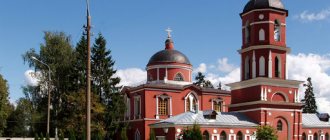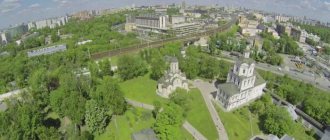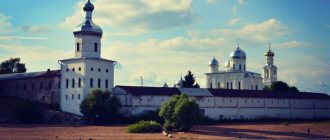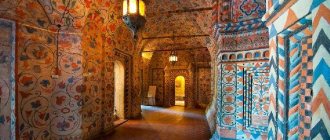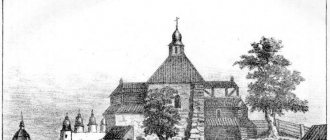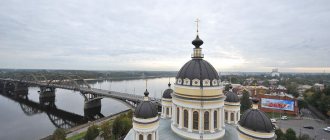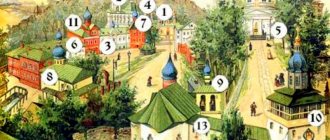Temple and its structure
Typically a temple[1] consists of a vestibule , a middle part and an altar .
The narthex is the western part of the temple. To enter it, you need to climb the steps to an elevated platform - the porch . In ancient times, the catechumens stood in the vestibule (this is the name given to those preparing to receive baptism). In later times, the vestibule became the place where, according to the rules, the betrothal, the lithium during the all-night vigil, the rite of announcement, and the prayer of women in labor are read on the fortieth day. The narthex is also called the meal, since in ancient times love suppers were held in this part, and later meals after the liturgy.
From the vestibule, a passage leads to the middle part , where worshipers are located during services.
Iconostasis
The altar is usually separated from the middle part of the temple by an iconostasis . The iconostasis consists of many icons. To the right of the royal doors is the icon of the Savior , to the left is the Mother of God . To the right of the image of the Savior there is usually a temple icon , that is, an icon of the holiday or saint to whom the temple is dedicated. On the side doors of the iconostasis are depicted the Archangels, or the first deacons Stephen and Philip, or the high priest Aaron and Moses. of the Last Supper is placed above the royal doors . The complete iconostasis has five rows. The first is called local: in addition to the icons of the Savior and the Mother of God, it usually contains a temple icon and locally revered images. Above the local one there is a festive row of icons: icons of the main church holidays are placed here. The next row is called deisis, which means “prayer.” In its center is the icon of the Savior Almighty, to the right of it is the image of the Mother of God, to the left is the Prophet, Forerunner and Baptist John. They are depicted facing the Savior, standing before Him in prayer (hence the name of the series). The images of the Mother of God and the Forerunner are followed by icons of the holy apostles (therefore, another name for this series is apostolic). Saints and Archangels are sometimes depicted in the deisis. In the fourth row there are icons of the holy prophets , in the fifth - the holy forefathers , that is, the ancestors of the Savior according to the flesh. The iconostasis is crowned with a cross.
The iconostasis is an image of the fullness of the Kingdom of Heaven; the Mother of God, the Heavenly Powers and all the saints stand at the Throne of God.
The altar is a special, holy, important place. The altar is the holy of holies of an Orthodox church. There is a throne on which the Sacrament of Holy Communion is performed.
At the altar
The altar is an image of the Kingdom of Heaven, a mountainous, sublime place. There are usually three doors leading to the altar. The central ones are called the royal doors . They are opened in special, most important and solemn places of service: for example, when the priest brings out the chalice with the Holy Gifts through the royal doors, in which the King of Glory, the Lord Himself, is present. There are side doors on the left and right of the altar barrier. deacons , most often pass through them during services .
Altar is translated as an elevated altar. And indeed the altar is located higher than the middle part of the temple. The main part of the altar is the Throne , on which the Bloodless Sacrifice is performed during the Divine Liturgy. This sacred action is also called the Eucharist, or the Sacrament of Communion. We'll talk about it later.
Throne
Inside the throne are the relics of saints, for in ancient times, in the first centuries, Christians celebrated the Eucharist at the tombs of holy martyrs[2]. On the throne there is an antimension - a silk cloth on which the position of the Savior in the tomb is depicted. Antimins translated from Greek means instead of a throne, since it also contains a piece of holy relics and the Eucharist is celebrated on it. At the antimension, in some exceptional cases (for example, during a military campaign), the Sacrament of Communion can be performed when there is no throne. On the throne stands a tabernacle , usually made in the form of a temple. It contains spare Holy Gifts for giving communion to the sick at home and in the hospital. Also on the throne is the monstrance , in which the priests carry the Holy Gifts when they go to give communion to the sick. On the throne is the Gospel (it is read during the service) and the cross . Immediately behind the throne there is a seven-branched candlestick - a large candlestick with seven lamps. The seven-branched candlestick was still in the Old Testament temple.
Behind the throne on the eastern side is a high place , which symbolically marks the heavenly throne or the chair of the eternal High Priest - Jesus Christ. Therefore, an icon of the Savior is placed on the wall above the high place. On the high place there is usually an altarpiece of the Mother of God and a large cross . They are used to wear during religious processions.
In those churches where the bishop serves, behind the throne on stands there are dikiri and trikiri - candlesticks with two and three candles, with which the bishop blesses the people.
Altar
In the northern part of the altar (if you look directly at the iconostasis), to the left of the throne, there is an altar . It resembles a throne, but smaller. The Gifts are prepared on the altar - bread and wine for the Divine Liturgy. On it are sacred vessels and objects: a Chalice (or chalice), a paten (a round metal dish on a stand), an asterisk (two metal arcs connected to each other crosswise), a spear (a spear-shaped knife), a spoon (a spoon for communion), covers for covering the Holy Gifts (there are three of them; one of them, large and rectangular in shape, is called air ). Also on the altar there is a ladle for pouring wine and warm water (heat) into the cup and metal plates for particles taken from the prosphora.
The purpose of sacred vessels will be discussed in detail later.
Another altar item is a censer . This is a metal cup on chains with a lid topped with a cross. Coal and incense or incense (fragrant resin) are placed in the censer. The censer is used to burn incense during the service. The incense smoke symbolizes the grace of the Holy Spirit. Also, the incense smoke rising upward reminds us that our prayers should ascend upward to God, like the smoke of a censer.
Pulpit
The pulpit (Greek “to ascend”, “edge of the mountain”) is an elevated, semicircular protrusion extended into the temple in the middle of the solea, opposite the Royal Doors.
The bishop's pulpit is the quadrangular elevation in the center of the church , on which the bishop's pulpit is placed during services.
The pulpit in the center of the solea means ascension (Greek – “pulpit”). It marks the places from which the Lord Jesus Christ preached (mountain, ship), since the Gospel is read on the pulpit during the liturgy, litanies are pronounced by the deacon, sermons and teachings are pronounced by the priests, and bishops address the people from the pulpit.
The pulpit also announces the Resurrection of Christ, meaning the stone rolled away by an angel from the door of the Holy Sepulcher, which made all who believe in Christ partakers of His immortality, for which reason they are taught from the pulpit the Body and Blood of Christ for the remission of sins and eternal life.
Yu.I.
Ruban Ambon
- (Greek pulpit - “protrusion”, “elevation”; from the verb “to ascend”, “to rise”) - a special
elevated place in a Christian church, intended for reading the Holy Scriptures, preaching and other liturgical actions.
Judging by the few surviving monuments and descriptions, the ancient pulpit was a semicircular tower carved from marble, to the upper platform of which two staircases (“shoots”) led. The front side of the pulpit was decorated with sculptural images. In ancient churches of the basilica form, the pulpit was placed in the middle of the temple (if there was one) or on the right and left sides of the nave, if there were two (in some churches, one pulpit was intended for reading the Apostle, the other for reading the Gospel). On the upper platform of the pulpit there was a music stand for books, a candlestick and a seat for the bishop. The Novgorod pilgrim Anthony, who visited Constantinople in 1200 and left a description of the capital’s shrines, singles out the pulpit of the “Great Church” (St. Sophia of Constantinople), the main cathedral-parish church of Byzantine Christianity (“the pulpit is crystal, King Ustinian created with much wisdom, decorated in every possible way”) .
The pulpit of Sophia of Constantinople could become a prototype for ancient Russian pulpits, in particular, for the wooden pulpit of the St. Sophia Cathedral in Novgorod, built in 1533 under Archbishop Macarius and which aroused the admiration of contemporaries (“ambon velmi wonderful”). This is the only surviving ancient Russian pulpit of this type (currently located in the Russian Museum). From this ambo the Apostle and the Gospel were read, the most important hymns were sung, and the synodik was proclaimed (“they called the senodik”). The ritual of “Elevation of the Cross” was also performed on it during the holiday of the same name, and a special role was given to the Novgorod pulpit during the action of “Walking on a Donkey” (see Entry of the Lord into Jerusalem). Obviously, the pulpit in ancient Russian worship served as an image of the Heavenly Jerusalem, the ideal City and Temple, in which “sublime” (in the spiritual and even literal sense!) service takes place. After the 17th century such pulpits are disappearing.
Currently, there are two types of pulpits:
1. “Pre-altar pulpit” - a semicircular platform, which is like a continuation of the central part of the solea (opposite the Royal Doors), with its protrusion facing the worshipers. Here the deacon pronounces the litany and reads the Gospel, the priest preaches, and gives the communion and the cross to the worshipers at the end of the service.
2. “Bishop pulpit” - a square elevation in the middle part of the church (usually portable), on which the bishop vests and stands surrounded by clergy and believers up to the Small Entrance while he celebrates the Liturgy. Hence another name in liturgical books - “cloud place”. As a rule, it has two stages.
According to the authoritative Byzantine liturgical interpretation (XII-XIII centuries), “the pulpit represents the stone on which the angel, having rolled it away, sat near the door of the tomb when he announced the resurrection to the myrrh-bearers. The steps of the pulpit mark Jacob’s ladder” (Sophronia of the Patriarch of Jerusalem, Word containing the entire church history, 4). The same symbolic series is developed in more detail by the last Byzantine liturgist Simeon of Thessalonica (†1429): the throne is the coffin, the altar is the grave cave, “therefore the pulpit stands in front of the doors of the tomb , meaning the stone rolled away from the doors of the tomb, and rises into a sign of height Christian preaching, or the fact that an angel sat on top of him and preached the resurrection of the Savior,” and concludes: “That is why the priests and deacons, depicting angels, proclaim the Gospel in the pulpit” (Conversation on Holy Sacred Rites, Chapter 104).
Lit.: Krasnoseltsev N.F. On ancient liturgical interpretations. Odessa, 1894; Works of Blessed Simeon, Archbishop of Thessalonica. M., 1994; Kupriyanov I.K. Processions of the cross, local holidays and church rituals of ancient Novgorod. Novgorod, 1859; Klyukanova O. V. Novgorod pulpit 1533 // Sofia. Novgorod, 1998. No. 4. P. 18–20.
Interior design and architecture
Despite the fact that all Orthodox churches differ in their size, distinctive architectural features, as well as the types of materials that were used to build them, they all have the same internal structure.
Therefore, no matter where an Orthodox church is located, it consists of the same functional parts. Each part of the internal structure of the temple has its own special, clearly thought out practical purpose. Also, all parts have their own names, taking their origins from time immemorial.
In addition, along with its functional purpose, each part in the internal structure of the temple carries an important symbolic meaning, which should be clear to every believer who comes to the temple to pray. In this article we will look at the main parts of the internal structure of an Orthodox church, and also learn the meaning of some words from church terminology.
At the entrance to an Orthodox church, we are greeted by a porch - this is a porch or a small open terrace covered with a roof on top. Above the entrance doors there is always an icon depicting a saint, a specific event or holiday in honor of which this temple was built.
An interesting fact is that there are three doors leading to the temple. And this custom dates back to the ancient times of early Christianity, when men and women could not yet enter the temple through the same door. This long-standing tradition in the architectural exterior of temples has been preserved to this day.
Parts of the internal structure of the temple.
The internal structure of each Orthodox church is divided into three main parts, each of which carries its own specific functional and semantic load. Among them are the following:
- porch;
- the middle part is, in fact, the temple premises itself, the significance of which is emphasized by the appropriate interior design;
- altar.
Let us consider in more detail what features each of these structural parts is characterized by and what functional purpose it serves. In the Christian religious tradition, little has changed since ancient times, and therefore we can safely say that Orthodox churches built several centuries ago had the same structure.
The role of the vestibule in the temple.
In ancient times, the narthex could accommodate those visitors who had not yet accepted the Christian religion. They could simply come and watch the service, but they did not have access to the middle of the temple. This was a precaution to ensure that dark, unknown forces did not penetrate into the temple and it was not desecrated. But at the same time, it was necessary to attract people and instruct them on the path of the Christian faith.
the font was previously located - a special vessel intended for the baptismal ceremony. And only after the rite of baptism had been performed on him, a newly-made Christian could enter the temple to attend the service as a full-fledged parishioner. After this, he was given access to the middle part of the temple, where he could go up and venerate the icons, and also listen to the sermon of the priest, an Orthodox priest.
For the baptism of infants, small fonts were used, but for the baptism of adult parishioners, quite spacious fonts were subsequently made, which were skillfully decorated with images from mosaics on religious themes. And today, the fonts in some churches have become real works of art.
Nowadays, the porch has largely lost its original purpose, and is an ordinary vestibule through which anyone can get into the middle part of the temple. On holidays, when there are a lot of visitors to the temple, the narthex is crowded with people who arrived later than others and therefore did not have time to go inside the temple.
Previously, the Orthodox church was conventionally divided into three parts by small wooden bars - partitions, because it was believed that men and women could not be together during worship and prayer.
Nowadays, the temple is a single, spacious room, the central place of which is occupied by the iconostasis. It is an almost solid wall, decorated with many icons of Orthodox saints, which are placed in a clearly established order.
Salt device.
In front of the iconostasis there is a solea , which is a part of the temple raised by one step, which is designed so that believers have the opportunity to better see and hear the divine service.
The middle part of the solea protrudes forward and is called the pulpit - from it the Orthodox priest delivers a sermon, and the deacon reads the Gospel. This protruding part acts as a kind of stage from which parishioners can better see all the actions of the priest and hear his words.
Also on the salt there are fenced off places called “choirs” - this is where the choir is located during services. The choirs are located on the right and left sides. This is done because some church chants must be performed by two choirs at the same time.
Purpose of church lamps.
Also on the salt there is a large number of a wide variety of lamps, each of which has its own name and functional purpose. Ordinary candlesticks are placed on the floor, and chandeliers are suspended from the ceiling.
At first glance, the design of the chandelier resembles a very beautiful chandelier, which has several tiers, on each of which there are lit candles. However, these days they are often replaced with light bulbs.
In front of the icons, lamps - small lamps filled with oil. When candles burn in them, their flame, fluctuating from the slightest movement of air, creates in the temple an atmosphere of unreality and mystery of everything that happens. This feeling is greatly enhanced by the play of light and shadow on the numerous brilliant details of the iconostasis.
From the point of view of the Christian religion, fire expresses the fiery love of believers for God and specifically for the saint in front of whose face the candle is placed. That is why it is customary to place candles in front of the image of the saint to whom believers turn with a request for help or assistance in solving life issues.
During the service, the priest uses another lamp, which he carries in his hands and illuminates the believers with it. It consists of two crossed candles and is called dikiriy . When a service is conducted by a priest of a higher rank - a bishop or patriarch, a lamp with three candles is used - it is called trikirium .
An important part of the service is the ritual of using the censer. Since ancient times, special aromatic substances have been burned in censers. This custom has been preserved to this day in the Orthodox church tradition.
Smoldering in the censer, which is a small vessel with slits designed for the passage of air. During the service, the priest swings the censer and fumigates the believers, icons and holy gifts with fragrant smoke of incense. Rising clouds of fragrant smoke are a symbol of the holy spirit.
Construction of the iconostasis.
The iconostasis is a wall that separates the main room of the temple from the altar. This is one of the most beautiful parts in the interior decoration of an Orthodox church, because the entire wall of the iconostasis is decorated with icons of numerous Christian saints. Each icon depicts a specific saint or martyr, and they are all placed in a strict order.
There are three doors in the iconostasis. Two of them are small, and they are on the right and left sides. And in the center is the main door - the so-called Royal Doors.
The name of this door means that God himself (in the Christian religious tradition he is also called the King) invisibly enters this door during the service. Therefore, the Royal Doors are usually closed. Only priests have the right to pass through them.
Components of the altar.
However, the most important part of every Orthodox church is the altar . This is a closed, last part of the internal structure of the temple, into which access to believers is prohibited. Therefore, only clergy who perform certain ritual actions there to conduct a church service according to all the canons of the Christian religion have the right to enter there.
The central place in the altar is occupied by the altar, which is essentially an ordinary table. It is covered with an antimension - a silk scarf on which is hand-embroidered an image of the scene of the position of Jesus Christ in the tomb. An inscription is also made on the antimension about the date of consecration of this temple. The antimension consecrated by the patriarch is sent to the temple, and only from that time on can the ritual of worship be performed with it.
The antimins is covered with clothes - first a thin one, which is called srachitsa, and on top of another one - indium. Indiya in its appearance resembles a tablecloth made of expensive brocade, which goes down to the floor.
On the throne there is a cross, a Gospel in a richly decorated binding, and also a tabernacle - this is a special vessel that is intended for storing the consecrated prosphora.
On the left side of the throne there is another table, which is called the altar. Sacred vessels are kept on it - a chalice and a paten. The preparation of holy gifts for worship is also carried out on the altar.

